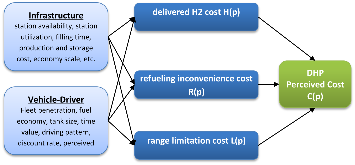A method for determining the optimal delivered hydrogen pressure for fuel cell electric vehicles
- Oak Ridge National Lab. (ORNL), Knoxville, TN (United States). National Transportation Research Center
- Argonne National Lab. (ANL), Argonne, IL (United States)
- Ford Motor Company, Dearborn, MI (United States). Research & Advanced Engr. Fuel Cell Center
- Chevron Corporation, Richmond, CA (United States). Process & Equipment Engineering Energy Technology Company
Fuel cell electric vehicles (FCEVs) are considered an important part of a portfolio of options to address challenges in the transportation sector, including energy security and pollution reduction. The market success of FCEVs depends on standardization of key vehicle and infrastructure parameters, including the delivered hydrogen pressure (DHP). This paper developed and utilized the Hydrogen Optimal Pressure (HOP) model to systematically identify the optimal DHP among 350, 500, and 700 bar toward the lowest total consumer cost and analyze how the optimal DHP may be affected by attributes of drivers, vehicles, and hydrogen refueling stations. The DHP of 700 bar a robustly better choice than 350 bar or 500 bar for Region Strategy, regardless of fuel availability, FCEV adoption, driver types, time values, and fuel economies. A DHP of 300 or 500 bar can the winner in Cluster Strategy if combined with certain assumptions of driving patterns and time value. the optimal pressure is found to be very sensitive to fuel availability, fuel economy, driving pattern and time value. The appeal of a higher DHP such as 700 bar (or even higher) is more obvious during the early market stages, when the number of hydrogen stations is limited and early FCEV consumers likely have higher time value, and thus may be willing to pay more for the increased range with higher DHP. Finally, future research on mixed DHPs within a station and across stations is suggested.
- Research Organization:
- Oak Ridge National Lab. (ORNL), Knoxville, TN (United States); Argonne National Laboratory (ANL), Argonne, IL (United States)
- Sponsoring Organization:
- USDOE Office of Energy Efficiency and Renewable Energy (EERE), Sustainable Transportation Office. Hydrogen Fuel Cell Technologies Office (HFTO)
- Grant/Contract Number:
- AC05-00OR22725
- OSTI ID:
- 1474701
- Alternate ID(s):
- OSTI ID: 2325044
- Journal Information:
- Applied Energy, Vol. 216; ISSN 0306-2619
- Publisher:
- ElsevierCopyright Statement
- Country of Publication:
- United States
- Language:
- English
Web of Science
Evaluating national hydrogen refueling infrastructure requirement and economic competitiveness of fuel cell electric long-haul trucks
|
journal | November 2019 |
Similar Records
Economic analysis of a high-pressure urban pipeline concept (HyLine) for delivering hydrogen to retail fueling stations
Manufacturing competitiveness analysis for hydrogen refueling stations
















